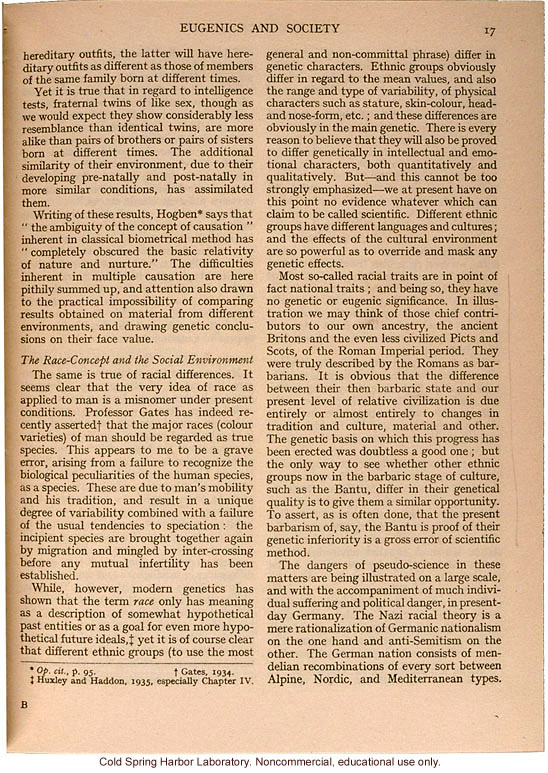"Eugenics and Society" (The Galton Lecture given to the Eugenics Society), by Julian S. Huxley, Eugenics Review (vol 28:1) (6)

"Eugenics and Society" (The Galton Lecture given to the Eugenics Society), by Julian S. Huxley, Eugenics Review (vol 28:1) (6)
1829. Eugenics and Society 17 hereditary outfits, the latter will have hereditary outfits as different as those of members of the same family born at different times. Yet it is true in regard to intelligence tests, fraternal twins of like sex, though as we would expect they show considerably less resemblance than identical twins, are more alike than pairs of brothers or pairs of sisters born at different times. The additional similarity of their environment, due to their developing pre-natally and post-natally in more similar conditions, has assimilated them. Writing of these results, Hogben* says that "the ambiguity of the concept of causation: inherent in classical biometrical method has "completely obscured the basic relativity of nature and nurture." The difficulties inherent in multiple causation are here pithily summed up, and attention also drawn to the practical impossibility of comparing results obtained on material from different environments, and drawing genetic conclusions on their face value. [italics]The Race Concept and the Social Environment[end italics] The same is true of the racial differences. It seems clear that the very idea of race as applied to man is a misnomer under present conditions. Professor Gates has indeed recently asserted[dagger] that the major races (colour varieties) of man should be regarded as true species. This appears to me to be a grave error, arising from a failure to recognize the biological peculiarities of the human species, as a species. These are due to mans' mobility and his tradition, and result in a unique degree of variability combined with a failure of the usual tendencies to speciation: the incipient species are brought together again by migration and mingled by inter-crossing before any mutual infertility has been established. While, however, modern genetics has shown that the term [italics]race[end italics] only has meaning as a description of somewhat hypothethical past entities or as a goal for even more hypothetical future ideals, [double dagger] yet it is of course clear that different ethnic groups (to use the most general and non-commital phrase) differ in genetic characters. Ethnic groups obviously differ in regard to the mean values, and also the range and type of variability, of physical characters such as stature, skin-colour, head- and nose-form, etc.; and these differences are obviously in the main genetic. There is every reason to believe that they will also be proved to differ genetically in intellectual and emotional characters, both quantitatively and qualitatively. But - and this cannot be too strongly emphasized - we at present have on this point no evidence whatever which can claim to be called scientific. Different ethnic groups have different languages and cultures; and the effects of the cultural environment are so powerful as to override and mask any genetic effects. Most so-called racial traits are in point of fact national traits; and being so, they have no genetic or eugenic significance. In illustration we may think of those chief contributors to our own ancestry, the ancient Britons and the even less civilized Picts and Scots, of the Roman Imperial period. They were truly described by the Romans as barbarians. It is obvious that the difference between their then barbaric state and our present level of relative civilization is due entirely or almost entirely to changes in tradition and culture, material and other. The genetic basis on which this progress has been erected was doubtless a good one; but the only way to see whether other ethnic groups now in the barbaric stage of culture, such as the Bantu, differ in their genetical quality is to give them a similar opportunity. To assert, as is often done, that the present barbarism of, say, the Bantu is proof of their genetic inferiority is a gross error of scientific method. The dangers of pseudo-science in these matters are being illustrated on a large scale, and with the accompaniment of much individual suffering and political danger, in present-day Germany. The Nazi racial theory is a mere rationalization of Germanic nationalism on the one hand and anti-Semitism on the other. The Germ nation consists of mendelian recombinations of every sort between Alpine, Nordic, and Mediterranean types. [left column hairline rule at base][footnotes] *[italics]Op. cit., p. 95. [dagger]Gates, 1934. [double dagger]Huxley and Haddon, 1935, especially Chapter IV. B [end]
- ID: 11744
- Source: DNALC.EA


